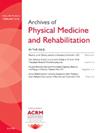Balance Interventions to Improve Upright Balance Control and Balance Confidence in People With Motor-Incomplete Spinal Cord Injury or Disease: A Systematic Review and Meta-analysis
IF 3.6
2区 医学
Q1 REHABILITATION
Archives of physical medicine and rehabilitation
Pub Date : 2025-03-01
DOI:10.1016/j.apmr.2024.07.013
引用次数: 0
Abstract
Objectives
To assist with clinical decision making, evidence syntheses are needed to demonstrate the efficacy of available interventions and examine the intervention components and dosage parameters. This systematic review and meta-analysis described the efficacy, components and dosage of interventions targeting upright balance control, balance confidence, and/or falls in adults with motor-incomplete spinal cord injury/disease (SCI/D).
Data Sources
A search strategy following the population, intervention, control, outcome framework was developed. Six databases were searched: APA PsychInfo, Cumulative Index to Nursing and Allied Health Literature, Embase, Emcare Nursing, Web of Science CC, and Medline.
Study Selection
Title, abstract, and full-text screening were conducted by 2 researchers independently. Inclusion criteria included the following: (1) adults with chronic, motor-incomplete SCI/D; (2) physical intervention targeting upright postural control; and (3) clinical and/or biomechanical measures of upright balance control and/or balance confidence and/or documentation of falls.
Data Extraction
Participant characteristics, balance intervention details, adverse events, and study results were extracted. The Downs and Black Checklist was used to assess methodological quality. Meta-analyses on pre-post intervention outcomes and a meta-regression of dosage were completed. Grading of Recommendations, Assessment, Development, and Evaluations approach was used to evaluate the quality of the evidence.
Data Synthesis
The search returned 1664 unique studies; 26 were included. Methodological quality was moderate to good. Participants were 500 individuals with SCI/D, aged 18-74 years (males: females = 2.4:1). Minor adverse events were reported in 8 studies (eg, muscle soreness and fatigue). Walking interventions and upright balance training with visual feedback had clinically meaningful and significant pooled effects on improving standing balance control. Only walking interventions had a significant pooled effect on improving balance confidence. There were no significant findings on dosage response. Few studies evaluated the effects of balance interventions on the occurrence of falls.
Conclusions
Walking interventions and upright balance training with visual feedback had greater effects on upright balance control than conventional physiotherapy; however, the quality of the evidence was very low.
改善脊髓运动不全损伤或疾病患者直立平衡控制和平衡信心的平衡干预:系统回顾与元分析》。
目标:为协助临床决策,需要进行证据综述,以证明现有干预措施的有效性,并研究干预措施的组成部分和剂量参数。本系统综述和荟萃分析描述了针对运动功能不全脊髓损伤/疾病(SCI/D)成人直立平衡控制、平衡信心和/或跌倒的干预措施的疗效、成分和剂量:数据来源:根据 PICO 框架制定了检索策略。共检索了六个数据库:APA PsychInfo、CINAHL、Embase、Emcare Nursing、Web of Science CC 和 Medline:标题、摘要和全文筛选由两名研究人员独立完成。纳入标准包括1)患有慢性、运动功能不全 SCI/D 的成人;2)针对直立姿势控制的物理干预;3)直立平衡控制和/或平衡信心的临床和/或生物力学测量和/或跌倒记录:数据提取:提取参与者特征、平衡干预细节、不良事件和研究结果。Downs和Black检查表评估方法学质量。完成了干预前后结果的元分析和剂量的元回归。采用 GRADE 方法评估证据质量:数据综述:通过检索,共检索到 1,664 项研究,其中 26 项被纳入。方法学质量为中等至良好。参与者为 500 名 SCI/D 患者,年龄在 18-74 岁之间(男性:女性 = 2.4:1)。有八项研究报告了轻微不良事件(如肌肉酸痛、疲劳)。步行干预和带有视觉反馈的直立平衡训练对改善站立平衡控制具有临床意义和显著的集合效应。只有步行干预对提高平衡信心有显著的综合效果。在剂量反应方面,研究结果并不明显。很少有研究评估了平衡干预对跌倒发生率的影响:与传统物理治疗相比,步行干预和视觉反馈直立平衡训练对直立平衡控制的影响更大;但证据的质量很低。
本文章由计算机程序翻译,如有差异,请以英文原文为准。
求助全文
约1分钟内获得全文
求助全文
来源期刊
CiteScore
6.20
自引率
4.70%
发文量
495
审稿时长
38 days
期刊介绍:
The Archives of Physical Medicine and Rehabilitation publishes original, peer-reviewed research and clinical reports on important trends and developments in physical medicine and rehabilitation and related fields. This international journal brings researchers and clinicians authoritative information on the therapeutic utilization of physical, behavioral and pharmaceutical agents in providing comprehensive care for individuals with chronic illness and disabilities.
Archives began publication in 1920, publishes monthly, and is the official journal of the American Congress of Rehabilitation Medicine. Its papers are cited more often than any other rehabilitation journal.

 求助内容:
求助内容: 应助结果提醒方式:
应助结果提醒方式:


